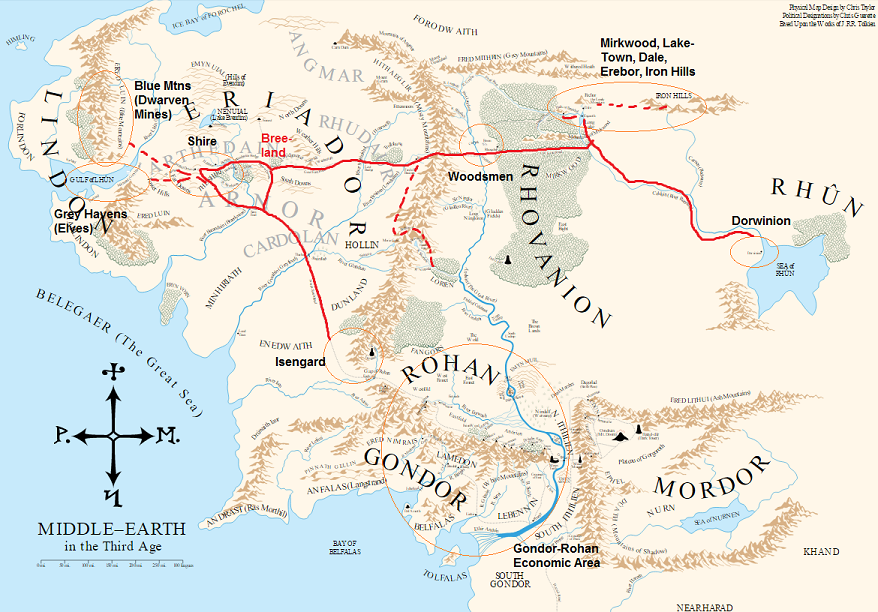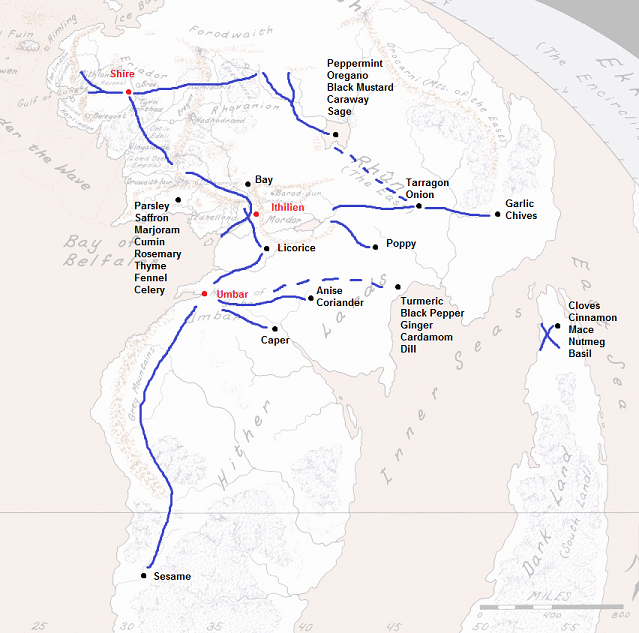Subject: I agree with what the others have said.
Author:
Posted on: 2016-01-05 14:33:00 UTC
If your story desperately requires an intricate knowledge of the trade-networks of late Third Age Middle-earth... then, actually, I'd love to read it, but I don't think it does. ^^
That said, someone asked questions, and you all know what I'm like. ^^
A lot of the answers are 'we don't really know', but since when has that stopped me? I took a few minutes to sketch out the known or inferred trade landscape of Middle-earth:

The first thing to note is that the continent is divided cleanly in two. Gondor and Rohan form a cohesive whole - they have masses of trade up Anduin, and a major road leading from the capital into allied Rohan. With Dol Amroth by the sea and various towns near the mountains, if you're in Gondor and Rohan, you can probably get hold of most things.
But they don't trade with the north. We know how much trouble Boromir had making the crossing at Tharbad - he lost his horse - so there can't be regular trade up the Greenway. So why have I drawn a big red line west of the Misty Mountains?
Saruman. Saruman traded with the Shire, and was interested enough to place spies in Bree. Saruman definitely uses the Greenway (possibly he has a hidden crossing outside Tharbad proper). Given that he doesn't really have much trade with Rohan, he also presumably has economic ties to his neighbours to the west - the Dunlendings who end up in his armies. Isengard is part of the northern economic area; he's not tied into Gondor's trade networks.
So, to the north. Over in the east, we have the trade network laid out in The Hobbit - Mirkwood, Dale, and Dorwinion down by the Sea of Rhun (no, it doesn't come from Bree, I'm afraid). I've included the Iron Hills in that area, since I doubt the dwarves all returned to the Lonely Mountain.
Dwarves are actually a key component of the northern trade network - they cut through the Shire on their way from the Blue Mountains to the Iron Hills (and later Erebor). They were seen, I vaguely recall, as somewhere between tinkers and peddlers - it's not noted as unusual that Gandalf brings dwarves with him to Bilbo's Party, or that they bring goods with them (though the Dale-marking is unfamiliar to the Shire-folk).
Elves also pass through the Shire, heading to or from the Havens, but they don't do so as traders - they camp out in the hills, and folk like Sam never see them. The Big Folk are known of, but not often seen (though Gandalf didn't get given suspicious glares or anything); we can probably infer some trade with Bree-land, though it seems the hobbits in both regions didn't travel.
In general, the Shire is a pretty insular economy - they have a strong tradition of re-use (see: mathoms), and until Saruman stuck his nose in, there's no indication that they had much new stuff. It was all just... well cared-for.
Bree-land is basically a farming region; it probably sprang up around the Prancing Pony and the Forsaken Inn (a day's ride east of Bree), as a stopover point for dwarves from the Blue Mountains (but it did so waaaaay back in the Second Age). I suspect the main trade pattern is: Barliman buys from the farmers, the farmers buy from travellers (and each other), travellers stay with Barley. The 'product' is food and rest, not anything exciting.
Rivendell isn't on the trade-map: one of the most subtle charges against Clbr_n is that it has traders coming to Elrond's hidden valley refuge. Yeah, no. Elves go there, and Rangers; other folks don't.
Moving on to your specific questions now, keeping in mind everything I've said above:
Salt probably comes from dwarvish mines in the Blue Mountains. There's no trade with the South, and the Havens don't seem to trade. So Sam might've bought a little every time a party of dwarves came through (there's a ficlet for you).
Money is one we've looked at recently, in the Boozonomics thread. Gondorian currency features two coin names, the castar and the tharni. The tharni is worth a quarter of the castar, and is also used to mean 'farthing' (as in East-, West-, South-), so what we have is coin names for 'penny' and 'farthing'. (These are the Westron names; in Sindarin, they're mirian and canath.)
It's a reasonable guess that Gondorian money is the same as Arnorian - they were economically connected, and words like 'penny' aren't going to diverge too much when the language itself - Westron - remains cohesive. So Barliman's silver pennies were castar. Per <a href="https://docs.google.com/spreadsheets/d/1mzkG-ImZWhzOdFJLYEmgazNjOMu-qdu0yMLNZ2phik/edit?usp=sharing">the Booze Standard spreadsheet, I've estimated them as being worth about £65, or somewhere between $70 and $90 (this is buying power, so the difference isn't the same as our exchange rate).
That makes a silver farthing worth about £15, which is far too high for the smallest currency unit - and silver is a precious metal anyway. Since a) I vaguely know that some old currencies had the same coin struck in different metals (for different values), and b) copper is a common metal for cheap currency, having copper pennies and farthings seems reasonable. Per the spreadsheet, copper is worth about 1/12 the value of silver (in the real world); given that Elves like the number 12, and Tolkien grew up with a system of 12 pennies to the shilling, 12 copper pennies to the silver penny works quite nicely. (This puts a copper farthing somewhere around the price of a drink in an inn, so yeah.)
The actual coins are probably a mix of different things - some Gondorian, some old Arnorian (probably the gold), possibly Isengard coinage, some dwarf- or even hobbit-minted coins. Barter would probably have been used in a lot of situations - rangers aren't going to be carrying much cash around, and Gaffer Proudfoot isn't going to force Gammer Bucklebey to scrape together some coins to buy potatoes when she can just promise him some of her eggs next time the hens lay some.
The Shire Post has a gorgeous line of Middle-earth coins, for what it's worth. They're not based on anything in the book (hilariously, they've turned the silver penny into a silver shilling, so they don't even have that!) but they're very nice. I have some. ^^
Paper is easy to make from wood pulp; I think it's fairly common. Bilbo was able to acquire a diary after setting off after the dwarves with nothing, for instance, and I think the majority of hobbits were literate (in the cirth, not the tengwar). Bree... well, if you say Barley was unusual, I'll accept that! Bree, Archet, Combe, and Staddle were basically inhabited by farmers, so they didn't need to read.
Bree-land's government is unknown. Bill Ferney doesn't get arrested for his assumed part in letting the horses out, so perhaps it's 'rule by the strong'. If Bree is a market-town for the other villages, it could be the leading merchants who run things. It's not the Rangers of Arnor - they're viewed as suspicious.
Sugar and spices... well, honey is a good source of sweetener if you don't have access to actual sugar. Do you have a quote for the spices? I can't think of anything, but if it's there, then I'd guess at Dorwinion, by way of Erebor. Maybe dwarves like curry. ^^
I think that covers most of it? And will take a few days to read? :D
hS
